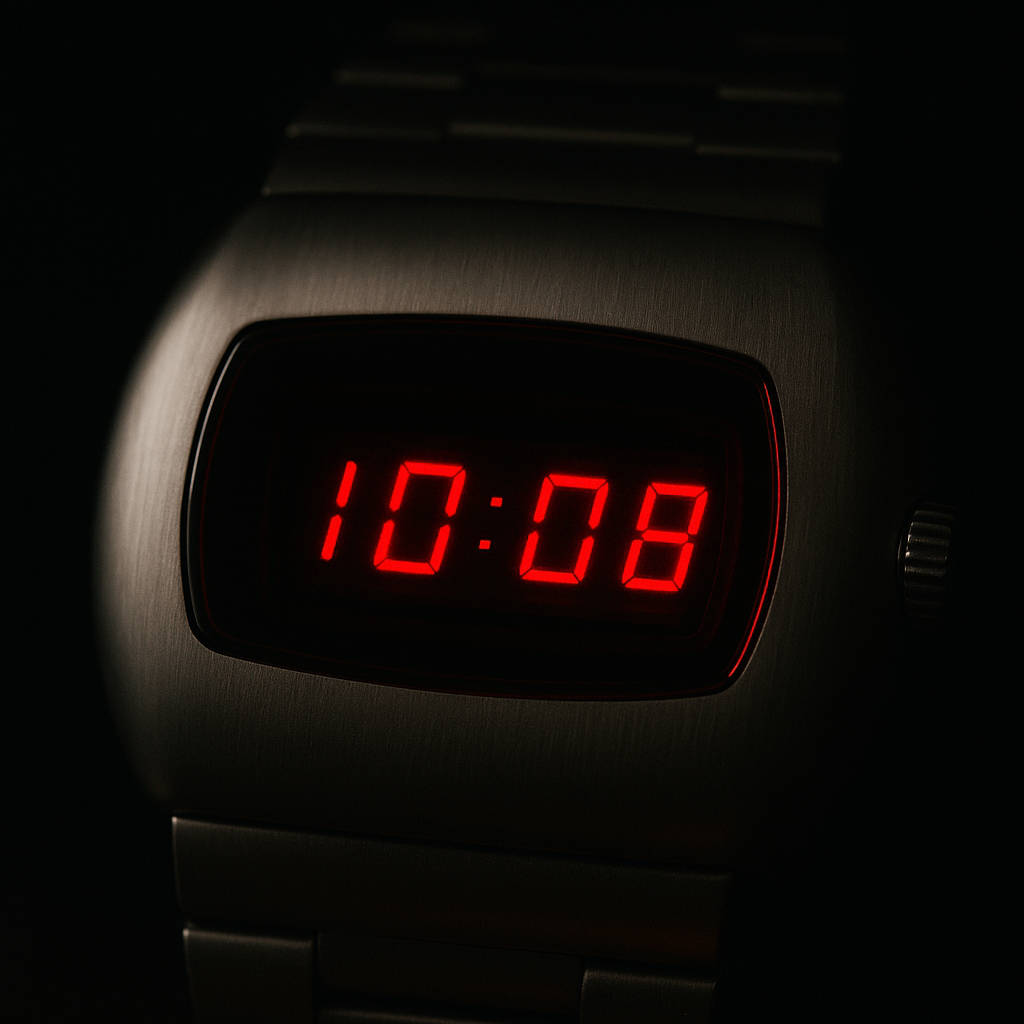In 1972, the world of horology witnessed a revolution. The Hamilton Pulsar P1, introduced that year, was the first digital wristwatch ever sold to the public. It marked the beginning of electronic timekeeping and transformed the way we read the time. No ticking hands. No moving parts. Just glowing red digits on command.
The Space-Age Origin of a Digital Legend
The concept of the digital watch started in Hollywood. In 1968, Stanley Kubrick’s 2001: A Space Odyssey featured futuristic props. Hamilton Watch Company was asked to create a high-tech timepiece for the film. Though it didn’t appear on screen, the idea stuck.
Hamilton partnered with Electro/Data Inc., a Texas-based electronics company. Together, they developed a working prototype. By 1970, they had created the first functional digital wristwatch. Two years later, it went to market as the Hamilton Pulsar Time Computer P1.
What Made the Pulsar P1 So Advanced?
The Pulsar P1 was unlike anything before it. It featured a bright red LED display made from Gallium Arsenide Phosphide (GaAsP). Pressing a side button would light up the hours and minutes for 1.25 seconds. This was necessary because early LEDs consumed a lot of power.
Under the hood, the watch used:
- A quartz crystal oscillator for precise timekeeping
- One of the world’s first custom integrated circuits in a wristwatch
- A solid 18K gold case, making it a luxury item from day one
Only 400 units were released in the first run. Each one sold for $2,100 — more expensive than most cars or mechanical watches at the time.
Fascinating Facts You Might Not Know
-
No Set Button: Early Pulsar P1 models didn’t have visible time-setting buttons. Instead, users had to use a magnetic stylus, hidden in the bracelet clasp, to set the time.
-
Serial Numbers Were Hand-Etched: Production was limited and artisanal. Each unit had a serial number engraved by hand on the case back.
-
Burn-In Risk: Early LED technology was unstable. Users who activated the display too often sometimes noticed faint “ghost digits” — an early case of display burn-in.
-
Elvis Presley Owned One: The Pulsar P1 quickly became a status symbol. Famous owners included Elvis, U.S. President Gerald Ford, and Fiat chairman Giovanni Agnelli.
-
Unique Display Box: It came in a curved, futuristic case with a built-in light, resembling something James Bond would use.
From P1 to P2: The Evolution of Digital Watches
Hamilton followed up the P1 with the Pulsar P2 in 1973. It featured a more ergonomic case, a visible set button, and improved reliability. It also appeared on the wrist of Roger Moore in the James Bond film Live and Let Die.
As the 1970s progressed, competitors like Seiko, Casio, and Texas Instruments entered the market. LCD (liquid crystal display) technology soon replaced LEDs, offering always-on displays and much better battery life.
The Pulsar line was eventually acquired by Seiko, which still uses the brand today.
The Legacy of the Hamilton Pulsar
The Pulsar P1 was more than a gadget — it was a vision of the future. It changed what people expected from a wristwatch. It proved that electronic timekeeping was not only possible, but desirable. Today, the P1 is a rare collector’s item and a symbol of innovation.
Only a few hundred units survive. In auctions, these watches can fetch tens of thousands of dollars.
For anyone interested in vintage digital watches, the story of the Pulsar is essential. It represents a moment when watchmaking jumped from the mechanical world to the digital one — and never looked back.
Frequently Asked Questions
Q: What was the first digital watch ever made?
A: The first digital watch was the Hamilton Pulsar P1, released in 1972. It used an LED display and was powered by a quartz crystal.
Q: How much did the Hamilton Pulsar P1 cost when new?
A: It originally sold for $2,100, which was more than many luxury watches at the time.
Q: How do you set the time on a Pulsar P1?
A: Early Pulsar P1 models used a magnetic stylus to activate hidden sensors on the case to adjust the time.
Q: Is the Hamilton Pulsar still available today?
A: The original P1 is no longer produced, but Seiko owns the Pulsar brand and makes digital and analog watches under that name.
Q: Are original Pulsar watches valuable today?
A: Yes. Original P1 models in good condition are considered collector’s items and often sell for $10,000–$25,000 or more.
